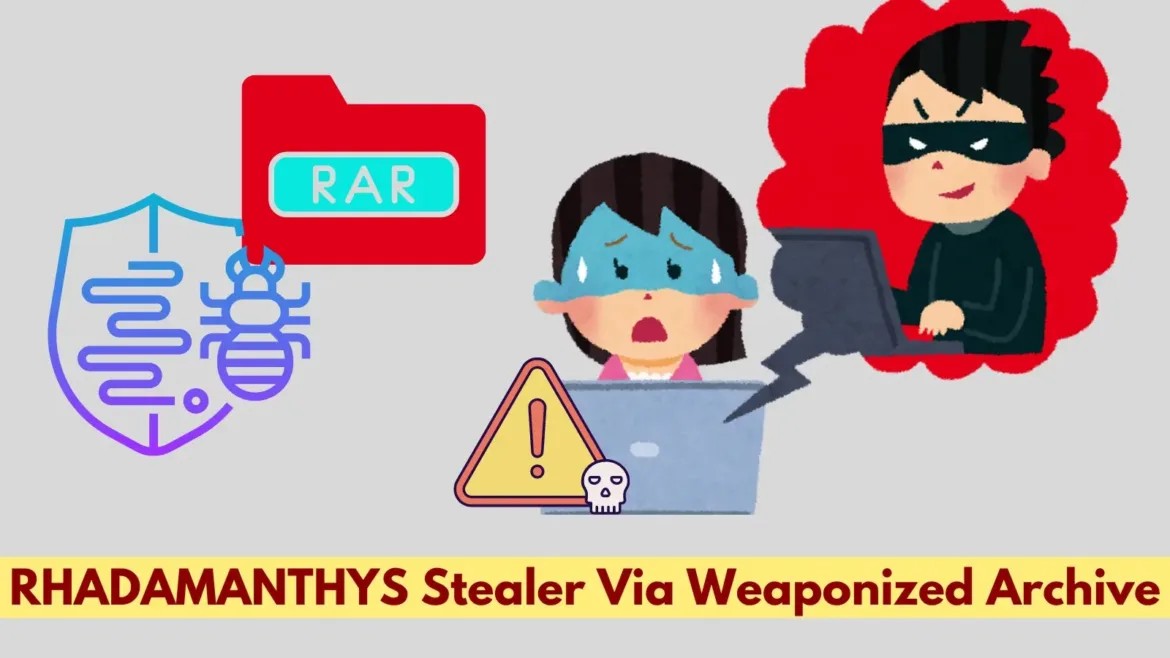RHADAMANTHYS Stealer Weaponizing RAR Archive To Steal Login Credentials

A newly surfaced cybercampaign focusing on Israeli customers has thrust the ravishing RHADAMANTHYS knowledge stealer into the spotlight.
Originating from Russian-talking cybercriminals and supplied as a Malware-as-a-Service, RHADAMANTHYS excels at records exfiltration.
Newest samples and in-depth diagnosis present a fancy an infection chain and broad payload capabilities, highlighting the evolving likelihood panorama and underscoring the need for sturdy defenses in opposition to this potent malware.

The assault employs a social engineering tactic, utilizing a Hebrew phishing email disguised as a sound notification from Calcalist and Mako.
An email leverages urgency and bother of acceptable repercussions by falsely claiming copyright infringement, prompting prompt action, which manipulates person psychology to bypass security features by exploiting time rigidity and fear about doable acceptable distress.
.webp)
A malicious email containing a locked RAR archive turn out to be encountered. Upon extraction, a suspicious executable named “תמונות מפרות זכויות יוצרים.exe” with SHA256 hash A7DBBAD8A1CD038E5AB5B3C6B1B312774D808E4B0A2254E8039036972AC8881A turn out to be chanced on.
It measures 1,804,072 bytes, is seemingly malicious, and requires additional diagnosis in a controlled atmosphere to make a choice its true efficiency and doable afflict.
Upon execution, the RHADAMANTHYS malware employs anti-diagnosis and anti-emulation ways to hinder detection internal sandbox environments, which initiates a multi-staged an infection route of, leveraging the supplied msimg32.dll and the next toughen file to place a foothold on the compromised gadget.
RHADAMANTHYS is a refined knowledge stealer employing route of injection into loyal Home windows processes to evade detection by utilizing anti-diagnosis tactics adore virtual machine and debugger detection and time-basically based evasion.
The malware persists via registry modification, exfiltrates sensitive records, including credentials, having a gape historical previous, cryptocurrency knowledge, and gadget tiny print, and communicates with its C2 server utilizing encrypted traffic over HTTPS and a non-favorite port.
In line with the researcher, it moreover functions as a downloader for subsequent malware payloads, posing a distinguished likelihood to compromised systems.
The malware exhibits malicious behavior all the way in which via extra than one gadget substances by aggressively conducting DNS lookups, potentially for evasive maneuvers or C2 communication.
Community connections to 103.68.109.208 on assorted ports by technique of extra than one processes present doable converse-and-alter mumble, which creates and manipulates information in non everlasting and person directories, suggesting records exfiltration and persistence mechanisms.
The a selection of registry adjustments made, such as autorun entries and browser tampering, supposed to get continual infections and alter person interactions, present a refined likelihood with the targets of information theft and gadget takeover.
Key APIs that originate these actions imaginable are VirtualAllocEx (which allocates memory internal the purpose route of), CreateRemoteThread (which runs injected code), RegSetValueEx (which makes adjustments to the gadget closing), and CryptEncrypt/CryptDecrypt (that is presumably old for encrypted communication with a converse-and-alter server).
The YARA rule tries to search out imaginable RHADAMANTHYS stealer malware by wanting obviously strings, a total code pattern, and file characteristics utilizing a combination of textual stammer material and hexadecimal patterns that match the malware’s sides.
To mitigate the likelihood, organizations may perchance maybe maybe well accrued prioritize email security via sturdy filtering and sandboxing, toughen person consciousness with phishing training, deploy advanced endpoint security, segment networks, on a customary basis backup excessive records, put in force patch administration, restrict application execution, and implement multi-part authentication.
Source credit : cybersecuritynews.com


